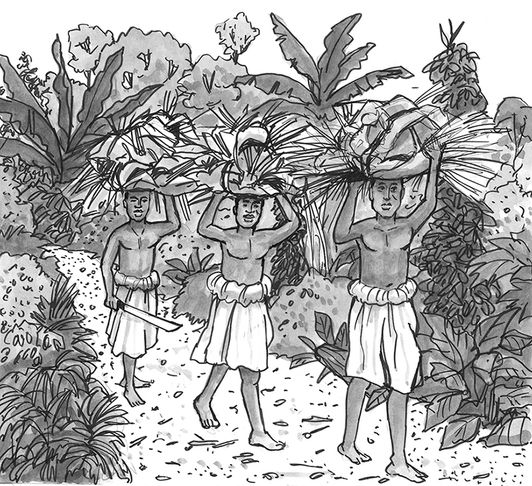Dorothy Brown Soper
ABOUT THE BOOK

Celebrating the Odwira festival in Kumasi where the king displays the Golden Stool
1807: KWAME, KWAKU, AND BAAKO live in the most powerful kingdom in West Africa. Kwame is the son of a chief. Kwaku is the likely successor to the chief. Baako is a slave, earning his freedom. The boys are good friends who work together daily. Guided by their families, elders, ceremonies, and stories, Kwame, Kwaku, and Baako strive to become leaders in the Akan culture.
In the capital city to see the king, the Golden Stool, and the Odwira festival, the boys meet foreign people, learn about writing and books, and witness the sale of slaves. Kwaku cares for a leopard cub that the king wants returned to the forest. On a mission to the coast, Kwame and Baako are kidnapped and threatened with sale as slaves.
The Asante Kingdom faces rebellion and the decline of its role in the Atlantic slave trade. Change will come. Kwame, Kwaku, and Baako balance the life they know with new possibilities for their future.
We Are Akan is a work of historical fiction for middle grade readers, their families, and educators. It follows three months in the lives of Kwame, Kwaku, and Baako, ages 11-13, who live in and near the fictional town of Tanoso in the Asante Kingdom.
The Asante Kingdom was real and existed for almost 200 years, 1701-1900. It grew to become the most powerful kingdom in West Africa of its time. The Akan were its principal ethnic group. At its height in 1807, the kingdom included most of the area that is now the nation of Ghana.
Greetings and a few common words and phrases in Twi, the Akan language, are included in the story. The words are translated when introduced and also listed with their translation in the glossary. Recordings of the Twi words and phrases along with a conversation in Twi are included on this website.
Two maps introduce the Asante Kingdom. All features are authentic except for the fictional town of Tanoso. The three parts of the story are summarized below. The maps and summaries are followed by photo galleries of the book's illustrations which may be downloaded and reproduced in limited quantity for educational purposes.
MAPS
VEGETATION ZONES OF THE ASANTE KINGDOM

THE ASANTE KINGDOM IN 1807

Part One: Our Town
Our Town introduces family and community life in Tanoso in 1807. Kwame, Kwaku, and Baako are good friends who work together learning to farm, throw spears, and understand the life of the forest including its animals from crocodiles and leopards to tsetse flies and ants. The boys have time for fun and talk of their future.
In a culture without schools, Kwame, Kwaku, and Baako learn through family life and work, plus stories, ceremonies, and celebrations. The chief, Nana Anyensu, the Queen Mother, and the elders of Tanoso govern the district and prepare the boys to become leaders. The community celebrates the Adae ceremony to honor ancestor chiefs and remind everyone of their history. Men, women, and children join together in the Adowa dance. An elder tells the story of the descent of the Golden Stool from the sky.
Their futures may be different, but Kwame, Kwaku, and Baako want to remain friends. They eagerly accept the chief’s invitation to join his delegation to visit Kumasi, the capital city, and take part in the Odwira festival.
Part Two: The Asante Kingdom
The Asante Kingdom follows Kwame, Kwaku, and Baako traveling on a great-road to Kumasi with the chief’s delegation. The boys expect to see the king, the Golden Stool, and the Odwira festival. In the capital city they discover the wider kingdom: fine crafts, cloth, and livestock in the marketplace, foreign people, reading and writing in Arabic, and the sale of prisoners as slaves.
The king tells the chiefs of his defeat of the Fante who had blocked the kingdom’s coastal trade. The Asante Kingdom has reached the height of its power although Fante rebels are active. Some whites on the coast no longer trade for slaves, which the kingdom has supplied, and want only gold and ivory. The future of this foreign trade, the kingdom’s primary source of manufactured goods, is unknown. The king’s officials give Nana Anyensu a leopard cub to return to the forest.
Nana Anyensu wants to buy a prisoner that slave traders are taking to the coast to sell. The chief gains permission for some of his group to join the king’s messengers traveling there and sends Kwame, Baako, and two elders. He places Kwaku in charge of the leopard cub. The grand Odwira festival takes place with thousands attending. Every chief pledges loyalty to the king and the Golden Stool.
Part Three: The Coast
The Coast describes the difficult journey from Kumasi to the Atlantic coast. Nana Anyensu’s representatives succeed in buying the prisoner they seek. Fante rebels rob the travelers and kidnap Kwame, Baako, and the newly purchased prisoner, planning to sell them as slaves at Elmina Castle. On their trek to the coast, the boys learn from the prisoner how to stay safe while hoping the king’s soldiers will rescue them.
Returning to Tanoso, Kwame, Kwaku, and Baako share their experience including their new knowledge of reading and writing and plans to use these skills. Nana Anyensu and the elders praise the boys as worthy of becoming leaders. The chief cautions the boys, saying that while change may come slowly, his people need leaders to prepare them. Nana Anyensu will adopt Baako, freeing him from slavery. The Queen Mother expresses confidence in the future.
Tanoso celebrates its Odwira festival to mark the beginning of the new year. Borne in his palanquin, Nana Anyensu leads a parade through the town. The festival closes when everyone gathers at the palace and the elders pledge loyalty to the chief. The community remains strong.































































